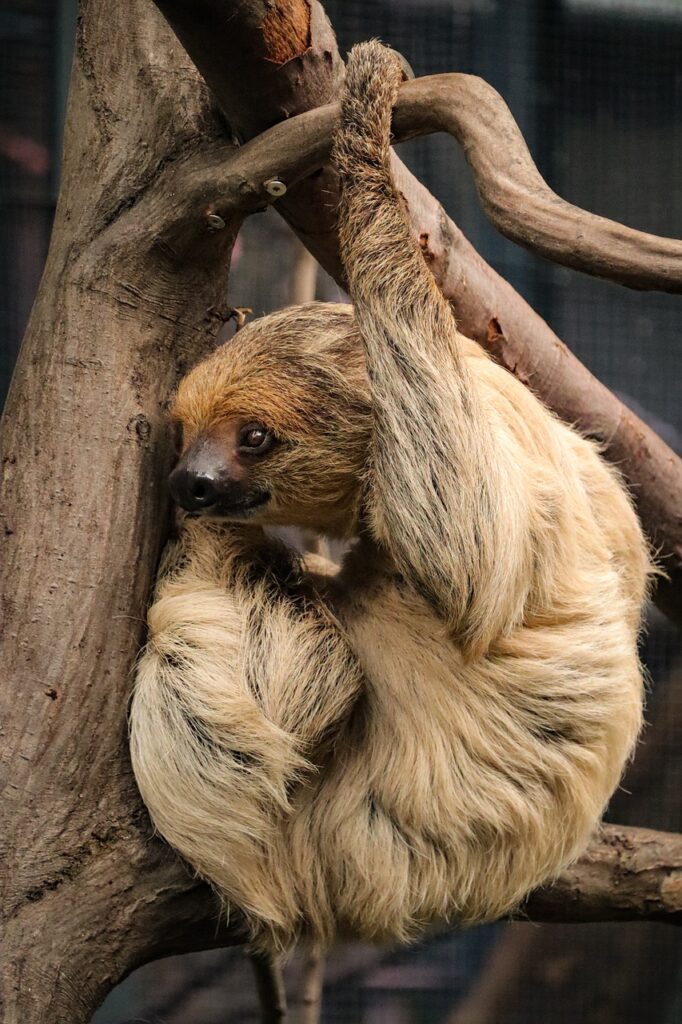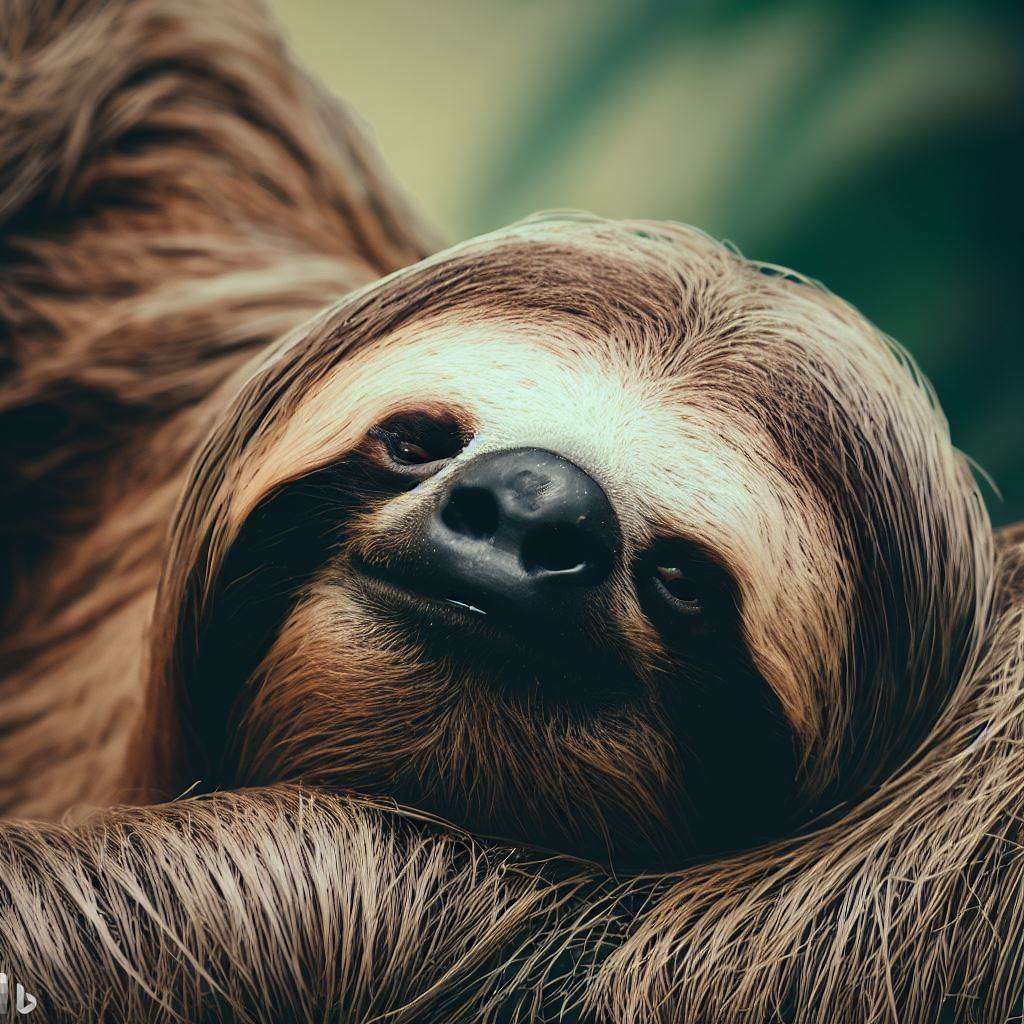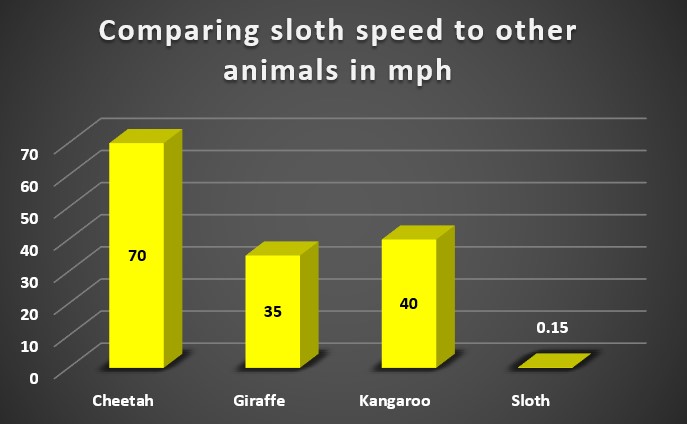
Image Credit: Pixabay
Sloths – slow-moving creatures of the Central and South American rainforests – are notorious for their lethargy and lack of agility. But do they have speed? Let’s investigate!
When we observe sloths in their natural environment, their slow movements are clear to see. But we must remember, sloths’ lifestyles are adapted to conserve energy and optimize survival. Not speed.
Surprisingly, sloths possess adaptations that allow them to move efficiently within the treetops. They have long, powerful arms, sharp claws for gripping branches, and specialized muscles for climbing. While they may not be fast compared to other animals, their ability to maneuver through dense foliage is still impressive.
Key Takeaways
- Sloths are indeed slow-moving creatures, with a top speed of about 0.15 miles per hour.
- Their slow movement is due to their low metabolic rate and specialized adaptations for a life spent mostly hanging upside down in trees.
- Sloths have a unique anatomy, including long limbs and curved claws, which allow them to move efficiently through the trees.
- Their slow pace helps them conserve energy and avoid detection by predators.
- Despite their sluggishness, sloths are well adapted to their environment and have successfully survived for millions of years.
What are sloths?

Sloths, the fascinating creatures known for their snail-like speed, are a peculiar addition to the animal kingdom. These arboreal mammals belong to the family Bradypodidae and are native to Central and South America’s tropical rainforests.
They have long claws and unique adaptations to enable them to hang upside down from trees. Their slow metabolism helps them survive on a diet of leaves, buds, and fruits. In the wild, sloths typically live for around 20 years.
Sloths have some amazing characteristics. They have an incredibly low body temperature, ranging from 76°F to 88°F. Plus, their feet vary from three-toed to two-toed, which aids their climbing and gripping abilities.
Witnessing a sloth’s leisurely lifestyle in the rainforest canopy is quite a sight. They nap up to 15 hours a day and take several weeks to digest a single meal. To really understand the calming beauty of these slow-moving creatures, one must experience it firsthand.
The misconception about sloth speed
Sloths are often known for being slow; however, this is not the case. They may not win any races, but they have special adaptations that let them move with agility and efficiency through trees. Their long limbs and curved claws give them a great advantage when moving through rainforest vegetation. Sloths can travel 13 feet per minute, which may not be fast, but it’s remarkable due to their size and physiology.
This leisurely lifestyle is actually an energy-saving adaptation. Sloths have a low-calorie diet, so they’ve evolved to move as little as possible. By staying upside-down on branches, sloths can conserve energy and keep predators away.
Understanding sloth movements
Sloths are well-known for their sluggish movements. Let’s explore the fascinating world of sloth movements to uncover some intriguing details.
We’ll analyze the different factors that contribute to sloth movements. Here’s a breakdown in a table:
| Type of Sloth | Average Speed (m/hr) | Habitat Preference |
|---|---|---|
| Two-toed Sloth | 0.24 | Tropical Rainforests |
| Three-toed Sloth | 0.19-0.24 | Canopy Trees in Central and South America |
Now, let’s delve into more interesting details about sloth movements. One remarkable factor is diet. Sloths mainly eat leaves, which lack nutrients, making digestion time longer. This leads to their slow metabolism and pace.
Through understanding sloth movements, we gain a deeper appreciation of their adaptability and survival strategies. And the benefits? Always being late, and never having to worry about burning calories!
The benefits of being slow for sloths

Slowness may seem like a disadvantage, but for sloths it’s actually a benefit. Being slow can aid their survival in many ways:
- Camouflage. Algae-covered fur gives them a green tint to hide from predators.
- Conserves energy. Low-energy diet means they don’t need much.
- Efficient climbers. Specialized limbs and strong grip help them climb.
- Evades predators. Slow movements make it hard to catch them.
- Mating strategies. Males use vocalizations and scent marking to attract females.
Sloths also possess adaptations, like their long claws, which help them hang upside down from branches and access food sources. Appreciate their deliberate movements and understand the essential role being slow plays in their survival strategy! Sloths make turtles and snails look like Usain Bolt and roller skaters respectively!
Comparing sloth speed to other animals

Sloths famously move slow, but how do they compare to other animals? Let’s take a look! Here’s a table of some of the top speeds of various critters:
| Animal | Speed |
|---|---|
| Cheetah | 70 mph |
| Giraffe | 35 mph |
| Kangaroo | 40 mph |
| Sloth | 0.15 mph |
While cheetahs and kangaroos zoom past at 70 and 40 miles per hour respectively, sloths inch along at just 0.15 miles per hour. This reveals how slow sloths are compared to other creatures.
Surprisingly, sloths use this slow pace for survival. It helps them conserve energy and remain undetected by predators. Plus, they can turn their head up to 270 degrees, so they can scan their environment better and spot possible danger.
Sloths teach us that life isn’t a race. It’s a leisurely crawl towards nap time.
Frequently Asked Questions
Q: Are sloths fast?
A: No, sloths are not fast. In fact, they are one of the slowest animals on Earth.
Q: How fast can sloths move?
A: Sloths move very slowly, typically only about 0.15 to 0.3 kilometers per hour.
Q: What is the reason for sloths being so slow?
A: Sloths have a slow metabolism and spend most of their time hanging upside down in trees, conserving energy.
Q: Can sloths move quickly if necessary?
A: Sloths are capable of slightly faster movements when they feel threatened or need to reach another tree for food or mating.
Q: Are there any advantages to being slow for sloths?
A: Yes, sloths’ slow movements help them avoid detection by predators such as jaguars and eagles.
Q: Do sloths have any adaptations to their slow lifestyle?
A: Sloths have specialized muscles and tendons that allow them to hang upside down for long periods without exerting much energy.
Conclusion
Sloths, symbols of slowness, have intrigued us with their special skills and laid-back lifestyle. Their evolutionary adaptation to hang around in trees has made them stand out in the animal kingdom.
Moving at a sluggish pace helps them save energy and stay hidden from predators. Their movements blend in with their environment, becoming one with the trees they live in. This serves as a natural shield against danger.
Sloths have a really slow metabolism, meaning they need much less food than other mammals. This helps them survive in tough conditions and use minimal energy for vital functions.
But there’s more to these cuddly creatures than just being slow! They can rotate their heads up to 270 degrees! This amazing cervical mobility means they can scan their surroundings without needing to move too much.
References
Why Are Sloths So Slow (Can They Ever Move Fast)? — Forest Wildlife

